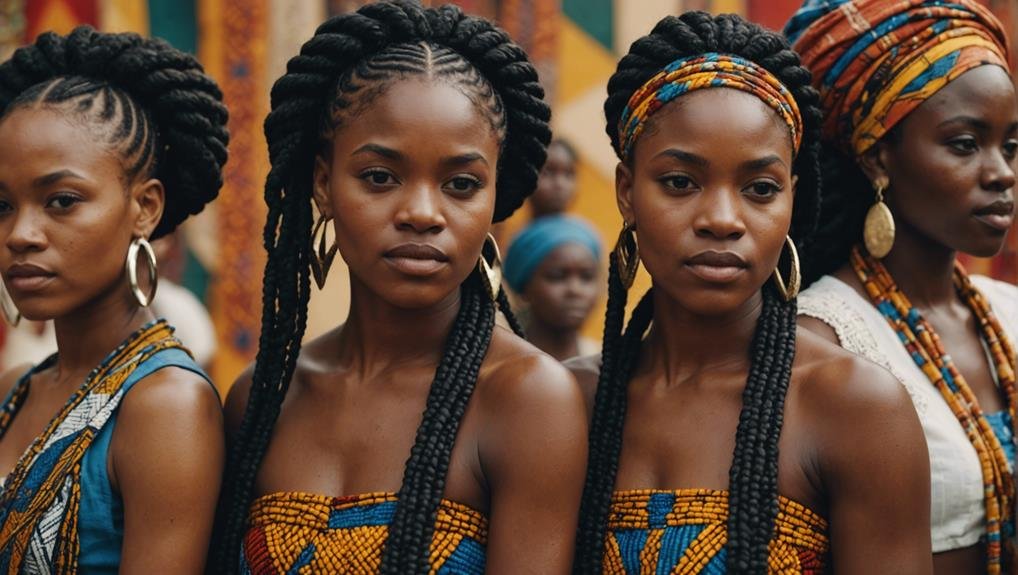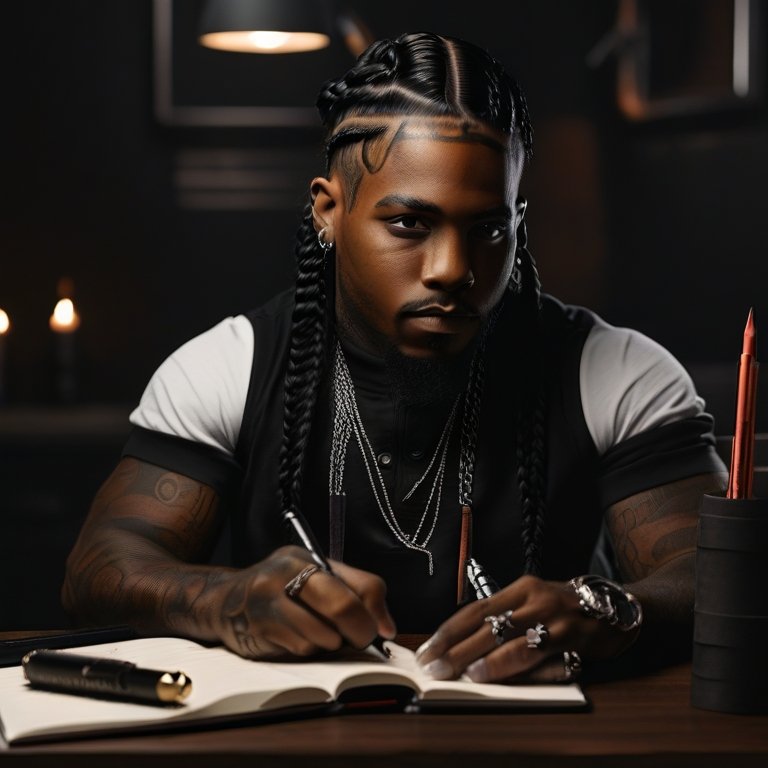You’ve likely noticed how braids aren’t just a hairstyle but a vibrant expression of cultural identity and history. As you explore the ‘Guide to Braids’ Cultural Impact in the African Diaspora, consider how these intricate patterns weave together stories of freedom, resistance, and beauty that resonate deeply across generations. Braids are more than strands intertwined; they’re a reflection of the resilience and creativity of the African communities. By understanding their roots and the significance they carry today, you’ll uncover how these styles are not merely aesthetic choices but are imbued with profound social and historical significance. What might surprise you is how braids are shaping modern cultural and economic landscapes.
Key Takeaways
- Braids symbolize resilience, cultural identity, and heritage within the African diaspora.
- Traditional braiding techniques connect individuals to their ancestors and preserve communal stories.
- Braiding serves as a form of economic empowerment and entrepreneurship for African women.
- In the diaspora, braids are worn as symbols of freedom, resistance, and pride against Western beauty standards.
- Braided hairstyles have been popularized in mainstream culture by influential figures, reinforcing a sense of cultural pride and diversity.
Historical Roots of Braiding
Braiding, a skill passed through generations, has deep roots in African history, dating back to ancient North Africa where women’s cornrows were first depicted in stone paintings. This traditional art form isn’t just a way to style hair; it’s woven into the fabric of African societies, reflecting societal customs and setting fashion trends.
As you explore braiding‘s rich history, you’ll discover that specific braided styles often indicated clan affiliation, marital status, or even age. This diversity in styles highlights how integral braiding is as a form of cultural expression. For example, Fula women in the Sahel region adorned their braids with silver and amber discs, adding layers of cultural and decorative elements that went beyond mere aesthetics. These embellishments weren’t just for beauty; they were steeped in the cultural aspects of their communities.
This intergenerational significance is profound. Braiding techniques and styles are passed down from grandmother to mother to daughter, each generation adding its own touch while preserving its heritage. This tradition reinforces communal ties and ensures that each strand isn’t just a part of individual identity but a continuous thread linking them to their ancestors. As you explore braiding, you’re not just looking at hair; you’re unraveling stories woven through time.
Symbols of Freedom and Resistance
After emancipation in 1865, African Americans embraced braided hairstyles as symbols of freedom. These styles weren’t just about aesthetics; they were declarations of independence and a reconnection to African roots. You can see braids as a canvas of cultural pride, displaying resilience in the face of ongoing discrimination.
During the Black Power Movement of the 1960s, braids took on new layers of significance. They became a bold statement of resistance against oppressive beauty standards and a rejection of assimilation. Braided hairstyles helped forge a shared identity, celebrating heritage and unity among African Americans.
Moreover, the covert messaging system within braids during slavery exemplifies the ingenious ways in which these hairstyles served as tools of survival and rebellion. Enslaved women wove maps and messages into their braids, plotting escapes to freedom. This historical context enriches the meaning of braided hairstyles, transforming them from mere fashion statements into potent symbols of freedom and resistance.
Today, when you wear your hair in braids, you’re not just choosing a style. You’re embracing a legacy of resistance, resilience, and pride in your heritage—a powerful reminder of where you’ve come from and the struggles you’ve overcome.
Braiding Techniques Across Cultures
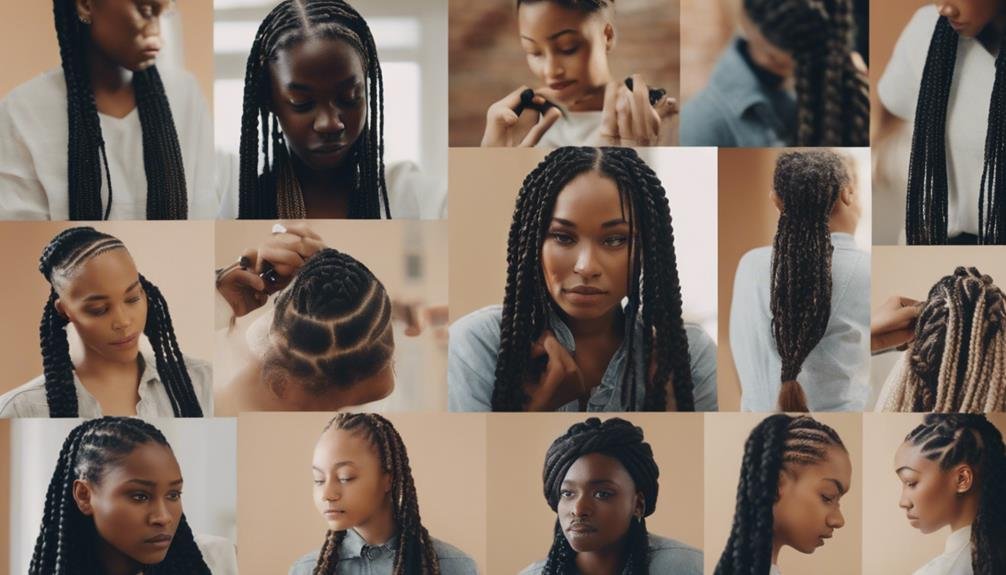
While braided hairstyles in the African diaspora often symbolize resistance and cultural identity, they’re just one example of the diverse braiding techniques found worldwide. You’ll find that African braiding styles such as cornrows, box braids, and twists not only serve aesthetic purposes but also embody deep cultural significance. In the Fulani culture, for instance, braids aren’t merely a style—they’re adorned with jewelry and beads, showcasing a rich heritage and identity.
Moving beyond Africa, Native American communities, including the Haudenosaunee, utilize braiding in more than just hair. They incorporate corn husk into their braiding, turning it into an art form that carries both practical and ceremonial value. In Scandinavia, braiding transcends simple hairdos. It’s part of traditional folk costumes, where intricate braiding techniques emphasize connections to heritage and craftsmanship.
Further east, in South Asian cultures, braiding goes hand in hand with opulence during celebrations. Intricate patterns woven with materials like silk and adorned with flowers characterize special occasions and ceremonies, reflecting a long-standing tradition that enhances beauty and cultural pride. Each braid, no matter the culture, weaves a story of identity, tradition, and community.
Economic Impact of Braiding
Hair braiding businesses not only support the financial independence of African women but also strengthen community ties and cultural heritage. As you explore the world of hair braiding, you’ll find that it’s more than just a style—it’s a crucial source of economic empowerment and entrepreneurship for African American women. These businesses don’t just provide income; they offer a pathway to financial independence and preserve important cultural traditions.
In your journey through this industry, you’ll see how these ventures greatly contribute to economic development within communities. However, it’s not always smooth sailing. You might face regulatory hurdles that can be tough to navigate and stiff competition that challenges your growth and sustainability. Despite these challenges, the resilience and innovative spirit of African American women shine through, driving the industry forward and reinforcing its cultural significance.
Braids in Contemporary Fashion
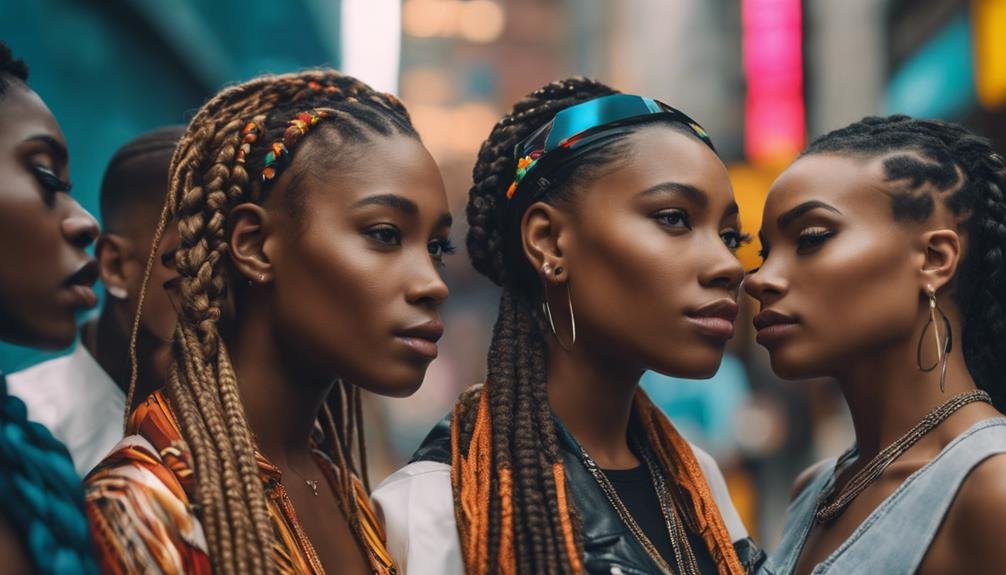
Moving beyond the economic side, braids have also carved a prominent niche in contemporary fashion. You’ll see braiding techniques that have deep roots in African cultural heritage now celebrated across high-end fashion runways and glossy magazine spreads. This isn’t just about a hairstyle; it’s a powerful form of self-expression and a nod to the resilience and creativity of Black people.
In the world of contemporary fashion, braids are more than a trend. They symbolize a movement towards diversity and the inclusion of natural hair aesthetics in the beauty narrative. Fashion designers and influencers aren’t just adopting braids; they’re adapting them, blending traditional African styles with modern twists that resonate with a global audience.
This shift isn’t superficial. It challenges the existing beauty politics by positioning braids as a high-fashion, artistic statement rather than merely an ‘alternative’ or ‘ethnic’ option. The growing visibility of braids in fashion media isn’t just changing how people style their hair; it’s transforming how beauty is defined, celebrating cultural identity while pushing the boundaries of mainstream fashion. Braids aren’t just worn; they’re making a statement.
Influential Figures and Braided Styles
How have influential figures shaped the popularization of braided hairstyles in modern culture? Throughout the decades, celebrated icons like Janet Jackson, Patrice Rushen, and Beyoncé have played pivotal roles.
Janet Jackson’s box braids in ‘Poetic Justice’ didn’t just define a film’s aesthetic; they sparked a widespread trend, influencing how braided hairstyles were viewed in mainstream fashion. You’ve likely seen how this style continues to resonate today, underscoring the enduring cultural impact of her look.
Patrice Rushen’s iconic braided hairstyles in the 1980s illustrated Black femininity and creativity, serving as a beacon of self-expression for many Black women. Her look encouraged you to embrace your identity and the versatility of braided styles.
Similarly, Beyoncé’s visual album ‘Lemonade‘ showcased various intricate braids, celebrating Black history and resilience, and reaffirming cornrow styles as symbols of Black beauty and pride.
These influential figures haven’t just been trendsetters; they’ve been cultural ambassadors, using their platforms to highlight and normalize the beauty of braided hairstyles within and beyond the African diaspora. Their impact shows you that braids are more than just a style—they’re a powerful statement of identity.
Braids in Media and Entertainment
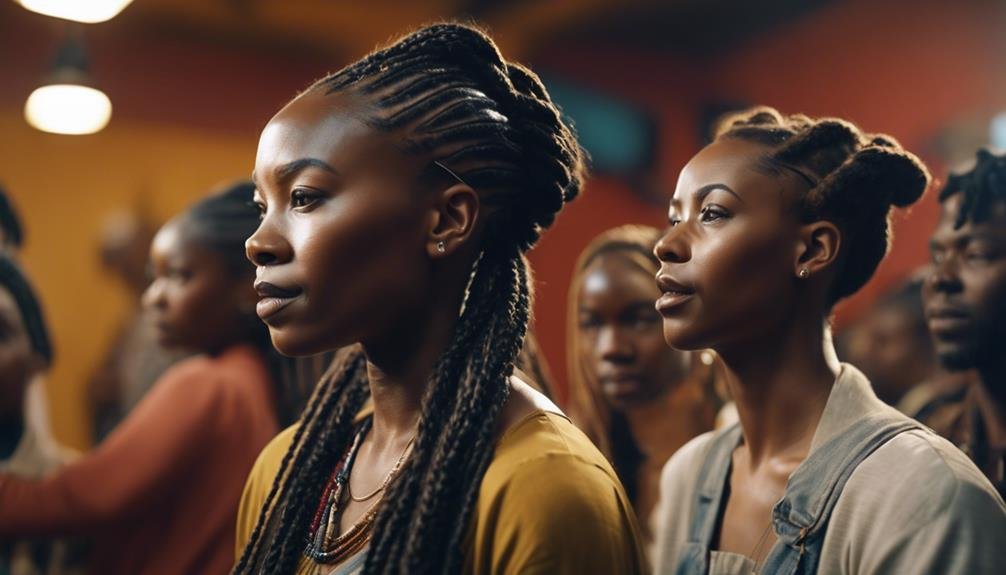
In media and entertainment, you’ve seen braids evolve from mere style statements to powerful symbols of heritage and beauty. African American celebrities like Beyoncé and Alicia Keys have showcased elaborate braiding techniques, embedding them deeply into mainstream media. These styles aren’t just about looking good; they’re acts of self-expression and resilience, standing against conventional beauty politics.
Braids have graced the screens in music videos, movies, and TV shows, making significant marks on pop culture. Remember Janet Jackson and Brandy in the 1990s? Their iconic braided hairstyles weren’t just trendy; they were declarations of cultural pride and Black power. These representations have helped to redefine what success looks like in the entertainment industry, asserting that African diasporic heritage is something to be celebrated, not concealed.
Despite facing challenges, the persistence of braided hairstyles in media portrays a powerful narrative of identity and heritage. They’re more than just a fashion choice; they’re a reflection of the unwavering spirit and enduring cultural pride of the African diaspora. As you watch these styles ripple through entertainment, it’s clear that braids are a profound form of Black self-expression and empowerment.
Social Movements and Hair Politics
Why did braided hairstyles become potent symbols during social movements? For African Americans, braided hairstyles became more than just a fashion statement; they embodied resistance, cultural pride, and a rejection of Western beauty ideals. During the Black Power Movement in the 1960s, embracing natural hair and braids was a way to assert self-expression and reclaim an African heritage that had been long suppressed by mainstream society.
The table below highlights key aspects of braids’ significance in social movements:
| Aspect | Description |
|---|---|
| Resistance | Braids symbolized defiance against conforming to Western beauty standards, particularly in professional and public spaces. |
| Cultural Pride | African Americans used braids to maintain and celebrate their cultural identity amidst widespread discrimination. |
| Self-Expression | Braids offered a personal and public statement of self-love and acceptance, challenging prevailing beauty politics. |
Celebrities like Cicely Tyson and Patrice Rushen weren’t just fashion icons; they were pivotal in bringing braided hairstyles into mainstream recognition, showing that these styles were beautiful, dignified, and powerful. This shift not only influenced beauty trends but also bolstered the confidence of countless African Americans to wear their hair naturally.
Innovations in Braiding
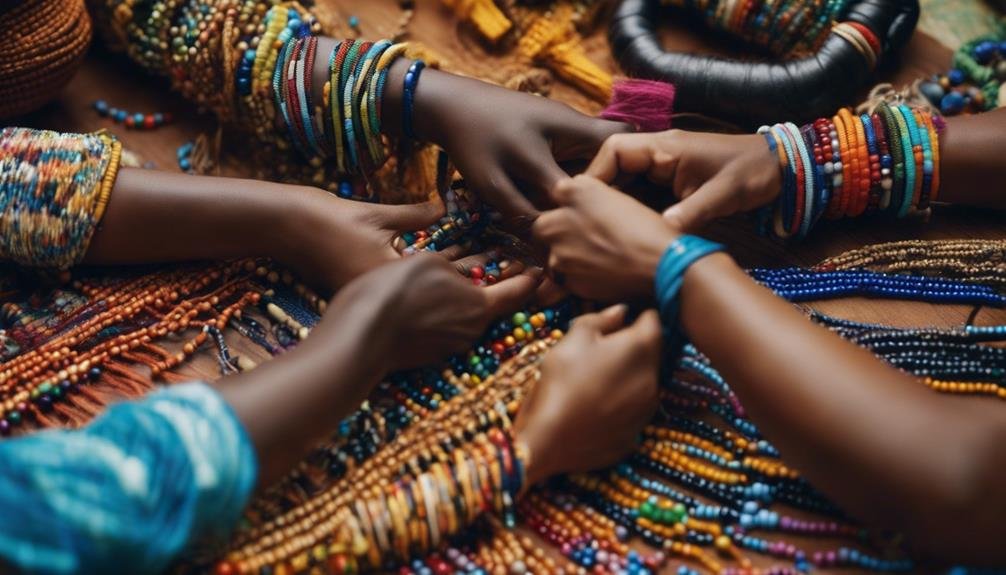
Braiders’ mastery and creativity have ushered in numerous innovations in braiding, merging traditional techniques with modern flair. As an African American, you’ve likely witnessed the profound impact braiding has on cultural identity and artistic expression. The evolution of braiding isn’t just about maintaining a dynamic form of self-expression and cultural heritage; it’s a vivid reflection of cultural customs, infused with contemporary aesthetics that resonate with today’s generation.
Here’s how you can appreciate these advancements:
- Diverse Braid Types: From sleek cornrows to voluminous box braids and elegant twists, the variety caters to every personality and occasion.
- Bold Colors and Patterns: Braiders now integrate an array of colors and intricate patterns, transforming simple braids into vibrant statements of identity.
- Innovative Accessories: Beads, rings, and wires aren’t just add-ons but integral parts of braiding that enhance the overall style and reflect skilled craftsmanship.
- Crossover Styles: Mixing braid types in one hairstyle offers a hybrid look that captures both tradition and modernity, showcasing creativity.
- Cultural Fusion: Incorporating elements from various African and African American traditions, braiders create styles that celebrate diversity and unity.
These innovations make certain that the art of braiding remains a dynamic form of self-expression and cultural heritage.
How Do Different Types of Braids Reflect Cultural Impact in the African Diaspora?
Different types of braids in African culture hold deep cultural significance within the African diaspora. From intricate cornrows to colorful beads, braids reflect a rich history and storytelling tradition. Each style carries a unique meaning, symbolizing heritage, status, and spirituality, and serves as a powerful expression of identity.
Preserving Traditions in the Diaspora
Exploring braiding traditions within the African diaspora keeps cultural heritage vibrantly alive across generations. As you immerse yourself in the intricate patterns woven into each braid, you’re not just styling your hair; you’re maintaining an essential link to your ancestors. Braiding isn’t simply a beauty routine; it’s a powerful affirmation of identity and a showcase of the cultural significance that these traditions hold.
Through adaptation, the braiding styles you choose reflect both the resilience and the evolution of your community. These styles have transformed, incorporating contemporary influences while staying deeply rooted in African heritage. It’s a dynamic expression of how your community has navigated through various cultures, yet held firm to its origins.
You don’t just wear your braids; you wear them with pride, knowing you’re part of a diverse tapestry that spans continents and centuries. Each twist and turn in your braids carries the stories of your forebears, bridging the past with the present, ensuring that the rich history and the connection to roots persevere.
Conclusion
As you’ve explored in this guide, braiding isn’t just a style; it’s a profound expression of culture and history in the African diaspora. By embracing braids, you’re not only celebrating beauty but also honoring resistance, heritage, and innovation.
Whether it’s through personal style, media, or political movements, your choice to wear braids connects you to a rich legacy. Keep weaving these traditions into your life and let each strand tell a story of resilience and pride.
